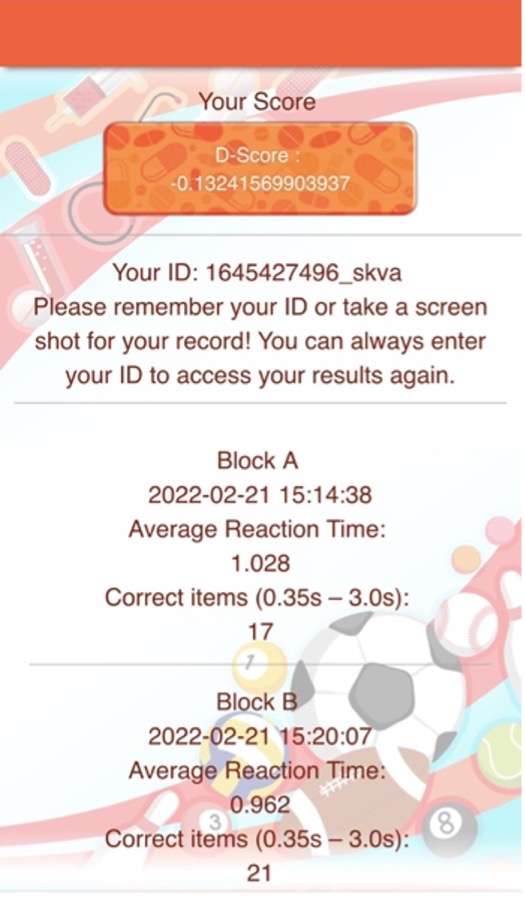NAME OF THE MOBILE APPLICATION:
Doping-IAT (accessible here: http://anti-doping.derwinchan.com/implicitassociationtest.html)
CATEGORY OF THE MOBILE APPLICATION:
Sport
PLATFORM:
Android, iOS, Windows, macOS.
COST: Free
ABOUT THE APP:
Doping-IAT is a mobile application that evaluates athletes’ implicit attitude towards doping. This implicit measure aligns with the protocol of the Doping-IAT computer test that Chan and co-workers[1] developed and validated among athletes in Australia. The response of the Doping-IAT may reflect athletes’ unconscious association of how much they like or dislike taking banned substances in sport.[1] With this digitalised version of Doping-IAT, athletes, researchers, and sport personnel may test athletes’ or sport participants’ implicit attitude towards doping using any mobile devices or computers.
The key assessment of Doping-IAT is the word-sorting tasks within the blocks where users are asked to sort words (i.e., stimuli) into categories of “I Like” (e.g., freedom, happy), “I Dislike” (e.g., crash, evil) or “Doping” (e.g., diuretics, narcotics). Users respond to the stimuli by pressing either the left or the right button as fast and accurate as possible (see Figure 1).
Following the completion of two blocks of word-sorting tasks in the order chosen by the user (i.e., Block A Block B, or Block B Block A), Doping-IAT will automatically and instantly compute users’ implicit attitude towards doping in a score, known as the Difference-Score (D-Score; Figure 2). The D-Score is an indicator of the extent to which someone holds a positive or negative implicit attitude towards doping. A positive D-Score denotes a greater implicit association towards doping, whilst a negative D-Score denotes a stronger implicit association to dislike doping. In addition to D-Score, Doping-IAT will also report the average reaction time and the number of correct responses in each block. Users may also retrieve and download the raw data of the Doping-IAT (by entering a unique ID of the test) for recording and analysis purposes.

IS IT USEFUL FOR CLINICAL PRACTICE?
Using implicit association tests for measuring athletes’ attitude towards doping may overcome the methodological limitations of traditional self-reported measures (e.g., Performance Enhancement Attitude Scale[2]) where the responses could be subjected to social desirability.[1, 3, 4] However, implicit doping attitude tests are typically not accessible to the general public because the execution of implicit association tests often requires certain software (e.g., E-Prime), laboratory setup (e.g., a computer workstation), and analytical procedures. Doping-IAT presents an evidence-based tool for measuring athletes’ implicit attitude towards doping that can be run in most smartphones or computer devices. It is useful for athletes, sporting or anti-doping organisations, and researchers.
PROS:
- Works on most operating systems for smartphones or computers
- Free of charge and free of advertisements
- Does not require installation of additional software
- Supported by prior research[1]
- Objective assessment of doping attitude
- Provide raw data for record and further analysis
CONS:
- Requires internet connection
- Users should have some basic knowledge about banned performance-enhancing substances in sport
- Available in English only
Authors and Affiliations:
Tracy Chor Wai Tang1
Manying Chiu1
Knuckles Ming Fai Cheung2
Derwin King Chung Chan1
1Faculty of Education and Human Development, The Education University of Hong Kong, Hong Kong, China1
App Mocha Limited, Hong Kong, China2
This paper is supported by a research project funded by World Anti-Doping Agency (WADA) Social Science Research Grants 2017 awarded to Derwin K. C. Chan. Correspondence concerning this article should be addressed to Derwin K. C. Chan, Faculty of Education and Human Development, The Education University of Hong Kong. Address: 10 Lo Ping Road, The Education University of Hong Kong, Tai Po, New Territories, Hong Kong. Email: derwin@eduhk.hk
References:
- Chan DKC, Keatley DA, Tang TC, Dimmock JA, Hagger MS. Implicit versus explicit attitude to doping: Which better predicts athletes’ vigilance towards unintentional doping? Journal of science and medicine in sport. 2018;21(3):238-44.
- Petróczi A, Aidman E. Measuring explicit attitude toward doping: Review of the psychometric properties of the Performance Enhancement Attitude Scale. Psychology of Sport and Exercise. 2009;10(3):390-6.
- Chan DK, Lee AS, Tang TC, Gucciardi DF, Yung PS, Hagger MS. Paper vs. Pixel: Can we use a pen-and-paper method to measure athletes’ implicit doping attitude? Frontiers in psychology. 2017;8:876.
- Petróczi A, Aidman EV, Nepusz T. Capturing doping attitudes by self-report declarations and implicit assessment: A methodology study. Substance abuse treatment, prevention, and policy. 2008;3(1):1-12.